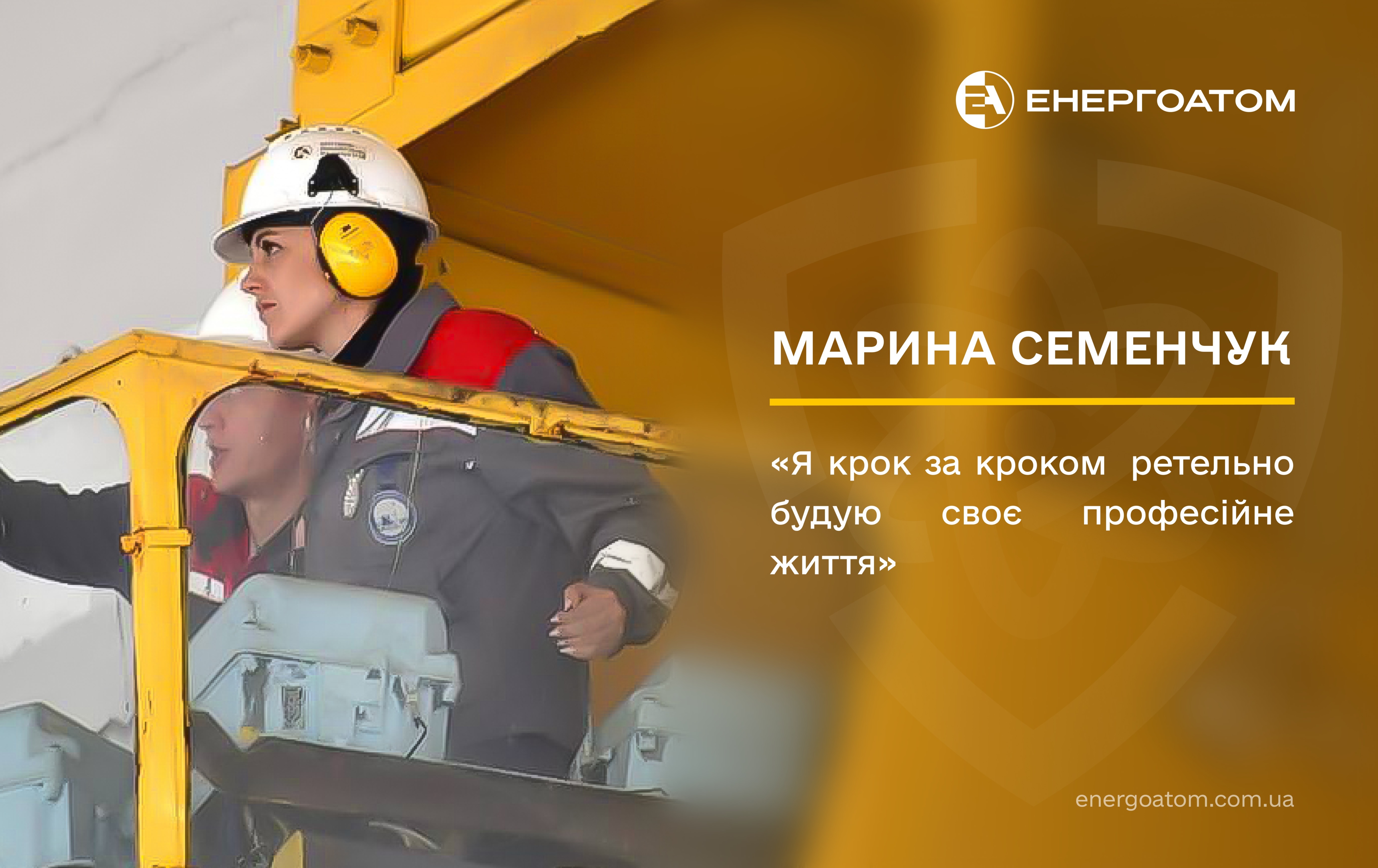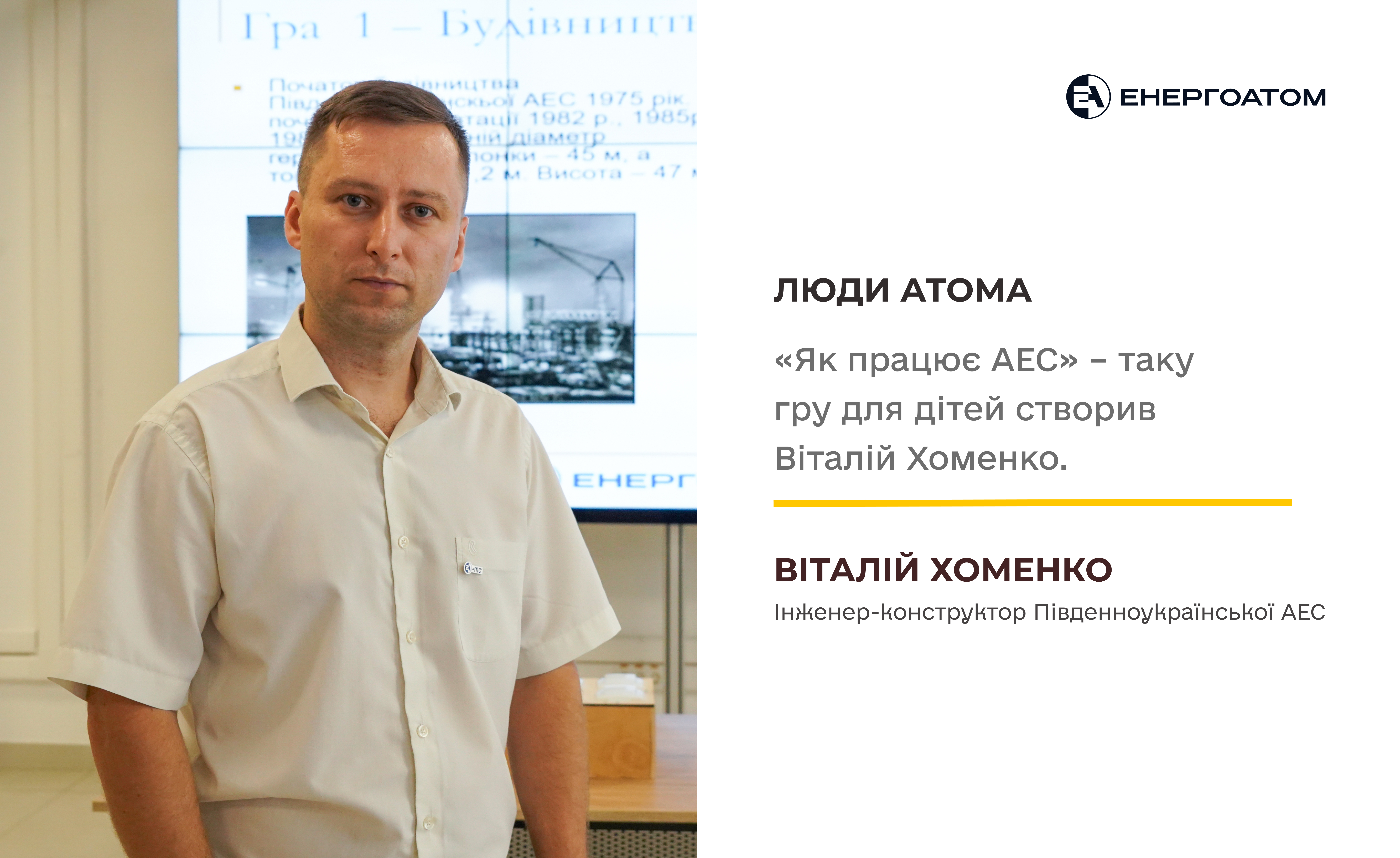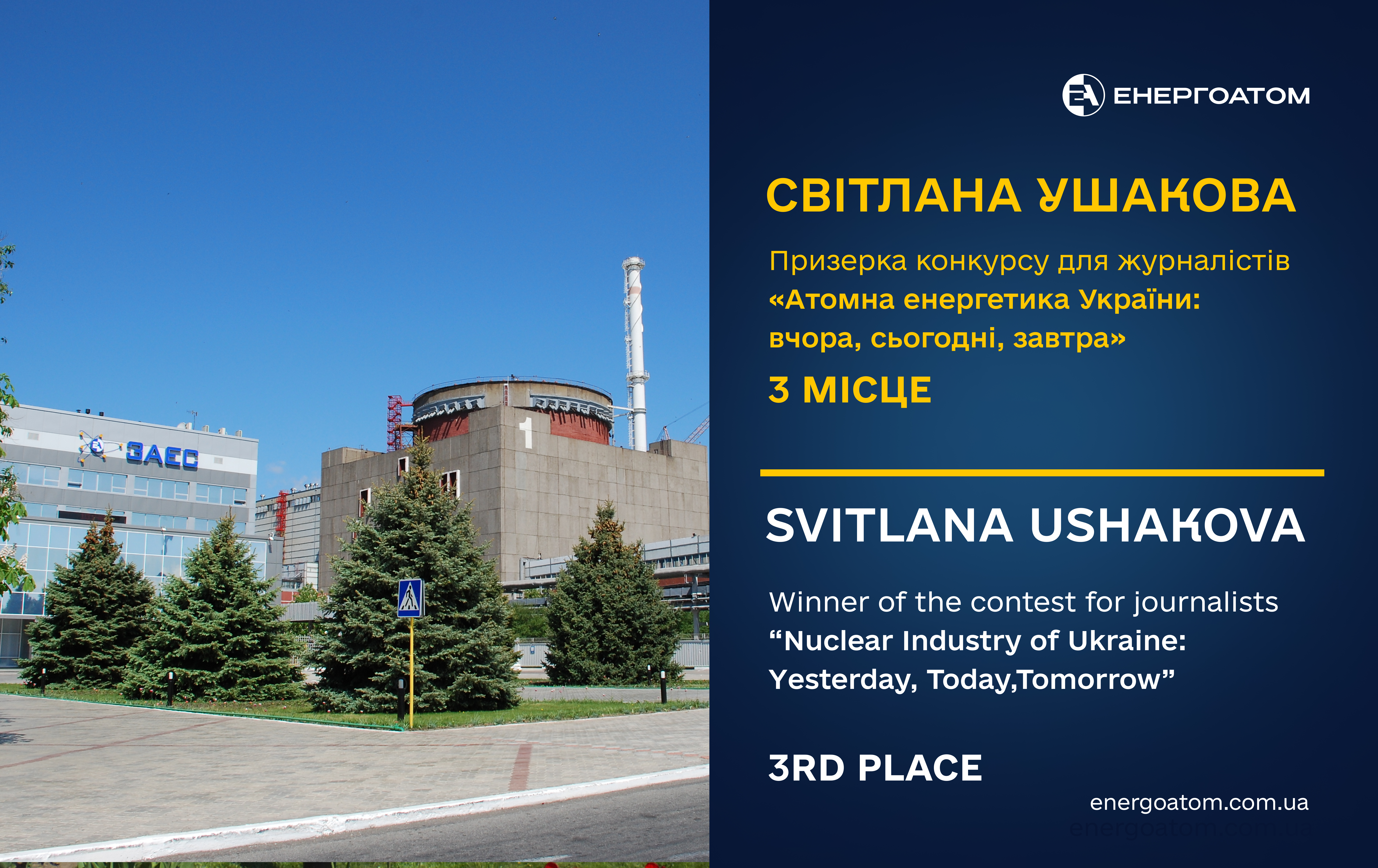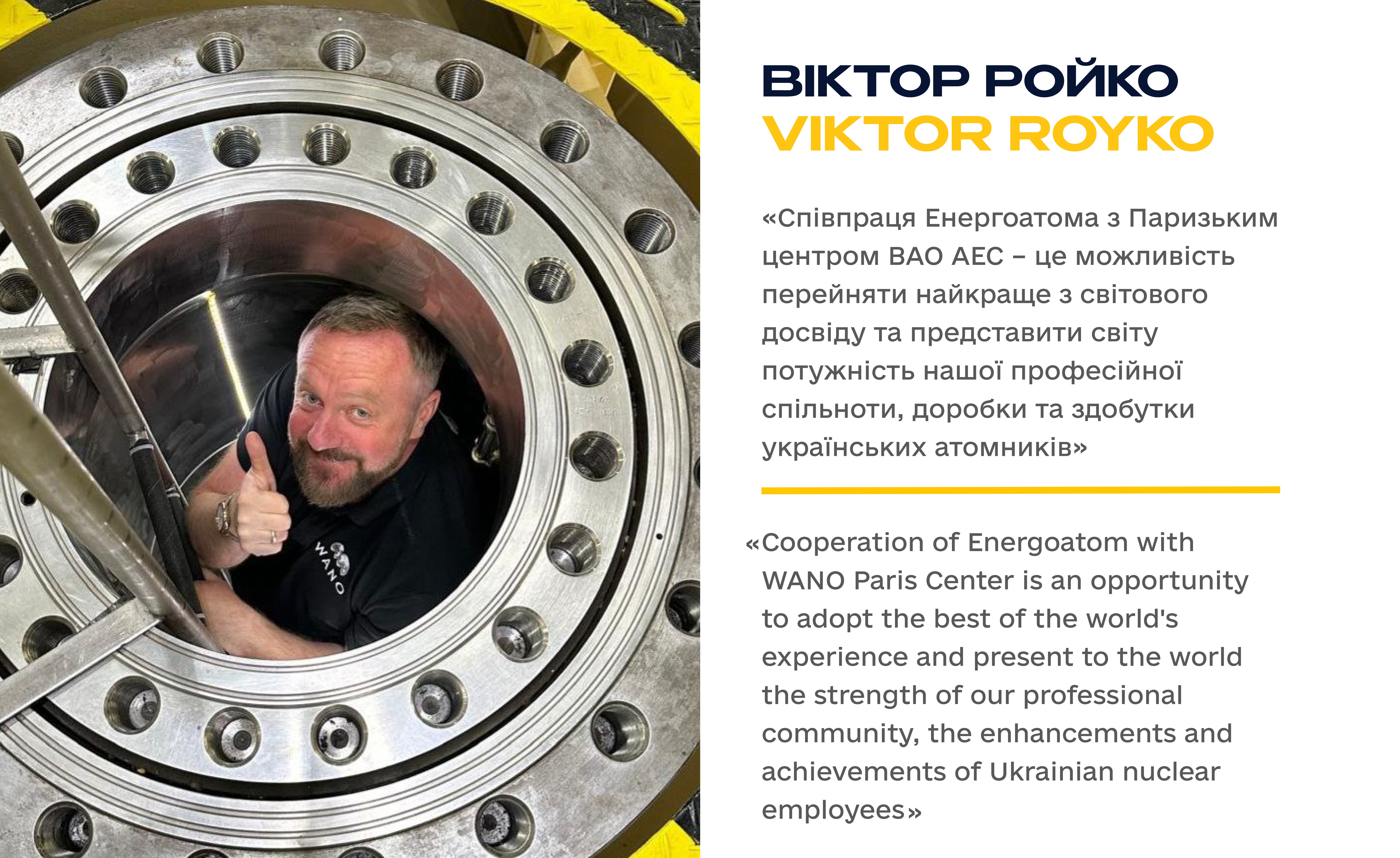06.04.2024
The PNPP employee Maryna Semenchuk: “I am carefully building my professional life step-by-step”

For the heroine of our publication, acquiring a difficult profession as a crane operator became one of the best decisions in her life. A strong character, which helps to overcome difficulties and certain stereotypes, suited her.
Can physically demanding work be interesting?
What is a crane operator's shift?
How does passion for her profession help in her professional development?
What should be the development of women in nuclear power industry?
Maryna Semenchuk, a creative, caring and gifted person, answered the above listed and other questions.
The heroine of our today's publication is Maryna Semenchuk, a crane operator of bridge and gantry cranes, of the 4th category, of the Branch “Pivdennoukrainsk NPP”. Maryna does not consider her profession to be male, on the contrary. About 80% of 42 crane operators in the workshop for the repair of lifting mechanisms and common-plant systems of the PNPP Maintenance Department are women. Therefore, regardless of gender, the only requirement for any job, in particular the profession of a crane operator, is high-quality and conscientious work performance. And if inspiration is added to mentioned characteristics, the work turns into a creative process.
There are three power units in operation at the Pivdennoukrainsk NPP. Maryna performs her work at each of them, and in addition, during outages, she works at onshore pump stations and in the special building. Now, according to her category, our heroine can operate bridge and gantry cranes with a load capacity of up to 50 tons. On the polar crane, which serves the actual reactor at level 38, crane operators of the highest, sixth category, work.
Do you have a goal to work on the polar crane?
Of course! For me, as a crane operator, this is the highest level. Such a crane is capable of lifting more than 400 tons. In order to operate it, one must have a very high level of knowledge and experience. Working on such a crane is like directly deal with the generation of electricity!
Prior to the time Maryna Semenchuk finished special courses in Mykolaiv and became a crane operator, she had been under the necessity of change several occupations: she managed production at a bakery, did accounting and finance, and even mastered one of the specialties in the field of beauty. Currently our heroine is getting a higher education at the Faculty of Engineering and Economics at the Admiral Makarov National University of Shipbuilding. But no matter what Maryna does, she has the same requirements for herself: attentiveness, responsibility and constant development.
No matter what anyone says, but it takes a certain amount of courage and resoluteness to get out of comfort zone and change a sufficiently calm work with a computer and papers to a large-scale production with complex equipment. How have you developed these traits?
This is probably from my childhood. There were six children in my parents' family: five sisters and a brother, I am the youngest. My brother, unlike my sisters, is only four years older than me, so he mostly took care of my education. Mother took care of the family herself. Dad, unfortunately, died very early. But he bequeathed to me a mathematical mind and a love of order even in small things.
These traits came in handy for me in choosing the profession of a crane operator. I really wanted to master physical labor. I would add attentiveness, attention to detail, as well as accurate knowledge of job duties to this list. The profession of a crane operator is physically demanding and requires the highest concentration of attention. It happens that several cranes are in operation in the hall, and you have to turn your head in all directions, trying to see everything around so as not to touch anything. However, even after such difficult, stressful changes, I feel a new lease of life. Perhaps this is an indicator that the job suits you. As for the fear of heights, this psychological barrier is quickly overcome.
How does a crane driver's work shift begin?
No matter what kind of work is planned for the shift, it always begins the same way - with a crane operational performance check. According to the job description, crane operators must know electrical and mechanical engineering, so we carefully inspect all the mechanisms. Mandatory inspection is also related to slings. The crane operator has the right to refuse to work with slings that do not meet the standards. Already being in the cabin, I do not make any movement without the slinger's command. We cannot hear each other while working, so we communicate using signs. Sometimes, several crews work at the same time, and safe work performance is the main priority. After all, the safety culture at Energoatom enterprises has been and should be at the highest level.
And the shift task, for example, can be as follows: we install the generator shaft sealing rings (GShS rings). By the way, I had to learn all abbreviations and acronyms very quickly. They should be treated as neatly as if they were crystal. You pick up this ring very carefully, the slinger also guides it so carefully. All activities are carried out at reduced speed. Sometimes you work the entire shift with these rings and only perform three lifting operations. But these three lifting operations will be equivalent to ten. Of course, I'm just talking about my feelings.
Have you ever had to use a crane to perform any special or more responsible activities?
You know, I can't say that any job is more special or more responsible. When you are part of a large nuclear family where everyone works like a bee, each in his/her specific area, you cannot say that somewhere is less or more responsible. Equally important is what is being carried: the rotor-related components or the 50-kilogram seal. You are afraid to blink, in order to prevent not to leave this load out of sight. Because the price of a mistake can be very high: I mean equipment, life and health of people.
How did your work start at the PAES?
After all the exams are passed, the permit is obtained, practice is prescribed, and the young machinist gets to his/her instructor, the crane operator of the 6th category. I am sitting and working, my instructor is standing next to me and teaching me crane tricks: how to understand the slinger, how to carry the load, how to check, how to react – here barely, here more, keep distance, look carefully here or there, etc. The training period lasts 2 weeks for each crane with which I have to work according to my category: up to 20, 30 tons, depending on which crane. One woman of the experienced crane operators assured me that I would understand when I was ready to work independently. And so it happened. You begin to feel the dimensions of the crane in the same way that any driver on the highway feels his/her car. Over time, you learn the character of each crane. The 15-ton crane on Unit 2, for example, has a temper, the 15-ton one on Unit 1 is soft and calm, and I started my work on the crane on Unit 3, and it is the most convenient for me.
In August 2023, you won the first place in the “Crane Operator” category in the competition of professional skills among young employees of еру PAES; later, in October of that year you proved your skills at the industry competition under the authorities of Energoatom.
Yes, it was a great opportunity to show my professional skills and learn something from my colleagues from other NPPs. Of course, I have also been interested in the operation of the Rivne NPP cranes, because I want to know as much as possible about my profession. I did not take first place at the industry competition, but the second result is also a great achievement for the PNPP. By the way, this year the industry competition of professional skills among young employees of Energoatom will be held at our site, at the PNPP. Therefore, taking this opportunity, on behalf of the Youth Organization, of which I am an activist, I would like to wish success to the girls and boys who will come to compete for the title of the best in his/her profession.
Do you feel like a part of the big Energoatom family?
Of course. Moreover, I see that in recent years, the topic that I am interested in – the policy of gender equality in the profession – has gained attention in our Company as well. I believe that the professional development of women is as important in the nuclear industry as in any other. After all, if a woman can be a crane operator or a welder, why can't she, having sufficient experience and appropriate education, manage crane operators or welders? If you talk about me personally, I consider myself a person who is quite capable of mastering the position of master or engineer even in a “male” workshop. Moreover, not only because there are many men at the front now, but I am also confident in my knowledge and responsible attitude to work. My further goal is to improve my qualification, and I am building my professional life step-by-step. Being enamored of my profession, I participate in competitions of professional skills, competitions of scientific reports and many other events; I am a member of the Youth Organization, etc. I am convinced that the direction implemented by Energoatom regarding the career opportunities of women at the enterprises of the nuclear industry, as well as nuclear industry women who seek professional development, will finally overcome the stereotype about the place of a woman at the Company's enterprises.
Gender equality is part of the corporate culture at JSC “NNEGC “Energoatom”. The Company's management promotes the development of the projects related to the involvement of women in the activities in power industry.
MORE NEWS

Game to get acquainted with NPPs based on Vitalii Khomenko's idea
20.09.2024

Svitlana Ushakova is a former employee of Zaporizhzhia NPP who spent more than a year in occupied Energodar. Six stories of Energodar residents who believe they will return to ZNPP
16.08.2024

For Viktor Royko, work at WANO Paris Center means personal development and new perspectives
26.07.2024

Oksana Kazymyrska: the Rivne NPP, international projects, WANO Paris Center
28.06.2024


 UA
UA





